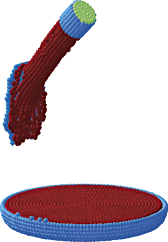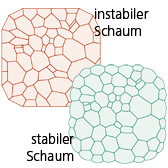Over a period of three years, we have worked on the development of a simulation tool for the refueling processes of motor vehicles based on the finite pointset method (FPM). The research was supported in the framework of a BMBF (Federal Ministry for Education and Research) program in cooperation with Volkswagen AG. The tool is supposed to offer a possibility for the technical design of fuel systems on the basis of simulations which also account for all the prescribed standards (refueling time etc.). One essential objective is to render the refueling of motor vehicle tanks as environmentally acceptable as possible.
Refueling of Motor Vehicles

Challenge Simulation of Foam
The refueling process is a very complex and polymorphous physical process. A first problem arises from the enormous geometric complexity of a motor vehicle tank, resulting from the more and more compact design of automobile construction. During the last few decades, a simple fuel can has developed into a high-tech unit. Another problem is the physical or dynamical behavior of fuel. Diesel in particular, but also gasoline tend towards the formation of foams, which have an essential influence on the refueling possibilities of the fuel system.
The foam will be considered as a homogeneous phase for the numerical simulations. However, foam has a very complicated structure consisting of bubbles, lamellae, webs, and nodes, so that a mathematical model is required for the consideration of foam as a phase.
The following aspects are particularly important:
- the stress-strain behavior of foam (material law), depending on the size of the bubbles and the content of liquid,
- the creation of foams at turbulent surfaces of a liquid and due to gases, which are contained or dissolved in the liquid, ascending by gravitation,
- drainage, i.e. the fluid transport through the system of foam lamellae,
- foam decay (i.e. the question how long a foam lamella exists before disintegrating).
The first point requires a more macroscopic method, by which we try to homogenize the system of foam bubbles and lamellae in order to represent the viscous, elastic, or plastic components of the stress behavior of the foam. The other points require a microscopic method in order to examine the flow behavior within a foam lamella, a web, or a node.
The entire refueling problem is a multiphase problem concerning air, foam, and fuel. Hence, special attention has been paid within the project to the formulation and implementation of consistent conditions at the phase boundaries.


Type of Project: BMBF-Verbundvorhaben
Project Partner: Volkswagen AG
